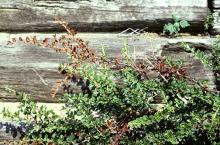See:
Pear (Pyrus spp.) - Fire Blight
Cause Erwinia amylovora, a bacterium. This is the same fire blight that attacks apple, pear, and other closely related plants. It usually goes unnoticed on ornamentals such as cotoneaster, hawthorn, and pyracantha. Cotoneaster horizontalis var. perpusillus has been reported to be especially susceptible.
Resistant (not immune) species have been identified including C. adpressus var. praecox, C. amoenus, C. apiculatus, C. canadensis, C. dammeri var. radicans, C. microphyllus, C. nitens and C. zabelii. Most reports on fire blight resistance, however, have been observational studies under landscape conditions. These results from observational surveys under low disease pressure may not be representative of performance under more severe conditions.
Symptoms A necrotic blight of the flowers and rarely shoots. Blossom blight is usually inconspicuous and may go unnoticed. Sticky drops of bacterial ooze may appear on the twigs and larger limbs. Larger limbs, when affected, are at first water soaked, then later become dry and crack. Infected succulent shoots display a characteristic shepherd's crook.
Cultural control
- Prune out affected twigs and limbs with tools sterilized after each cut with a solution of 10% Clorox (bleach) or shellac thinner (70% ethyl alcohol). Cut several inches below the affected area to make sure no disease is left in the bush.
- Plant cultivars with fire blight resistance including C. salicifolius 'October Glory' and 'Willeki', C. henryanus 'Corina', and C. dammeri 'Eicholz', 'Holsteins Resi', and 'Thiensen'.
- Follow control measures listed under Pear-Fire Blight.
Chemical control Fixed-copper products may be phytotoxic and must be applied only under fast-drying conditions. Group M1 fungicides.
- Agri-Mycin 50 at 2.7 to 8 oz/100 to 300 gal water/A. Tolerant strains of the bacterium easily develop with repeated use of this product. Alternate with other bactericides to prevent or delay buildup of tolerant strains. Group 25 fungicide. 12-hr reentry.
- Arbor-OTC is registered for trunk injection, see label for details. Group 41 fungicide (antibiotic). 12-hr reentry.
- Badge X2 at 1.5 to 2 lb/A. Group M1 fungicide. 24-hr reentry.
- Junction at 1.5 to 3.5 lb/A. May be useful when bacteria are resistant to copper products alone. Group M1 + M3 fungicide. 48-hr reentry.
- Nu-Cop 50 DF at 1 lb/100 gal water. Group M1 fungicide. 48-hr reentry.
- Phyton 27 at 2 to 4 fl oz/10 gal water. Group M1 fungicide. 48-hr reentry.
Note Phosphonate products (Group P7 fungicides) were not effective in a test in California.
References Hudgins, E., and O'Mara, J. 2001. Cotoneaster diseases in Diseases of Woody Ornamentals and Trees in Nurseries, R.K. Jones, and D.M. Benson. (ed.). Paul, MN: APS Press.
Rothleutner, J.J., Contreras, R.N., Stockwell, V.O., and Owen, J.S. 2014. Screening cotoneaster for resistance to fire blight by artificial inoculation. HortScience 49:1480-1485.

